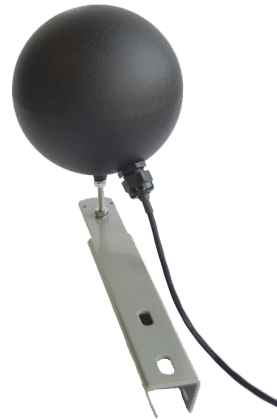






Resumen
The Black Globe Temperature Sensor for Heat Stress (Black Globe) uses a thermistor inside a 15.2 cm (6 in.) hollow copper sphere, painted black, to measure radiant temperature. This measurement, along with the measurement of ambient air and wet-bulb temperatures, may be used to calculate the Wet-Bulb Globe Temperature (WBGT) index.
Leer másImágenes






Descripción detallada
Loss of physical and mental efficiency occurs under definable degrees of heat stress. Severe heat stress can lead to fatigue, exhaustion, and possibly even disability or death. The Wet-Bulb Globe Temperature (WBGT) index combines the effects of temperature, humidity, radiant heat, and wind into one single index employed to express environmental heat stress.
Heat stress can be reduced by decreasing the lengths of exposure and decreasing the workload of individuals under heat stress. Situation factors such as the type of clothing worn, the type of work performed, the psychological effects of stress, and availability of fluids can affect the assessment of heat stress. These factors are not easily quantified, and so the individual in a given situation must estimate their significance. Environmental factors such as temperature, humidity, and wind are more easily measured to assess heat stress.
To calculate the WBGT index, the measurement of the black globe (radiant heat), wet bulb (evaporative heat), and ambient air (dry bulb) temperatures are required. The wet-bulb temperature can be calculated using air temperature and relative humidity if a wet-bulb thermometer is not available.
A custom cable length will need to be specified when the Black Globe is ordered. The maximum suggested cable length is 304 meters (1,000 feet).
Preguntas frecuentes
Número de FAQs relacionadas con BLACKGLOBE-L: 3
Expandir todoDesplegar todo
-
Heat stress refers to the human body’s inability to maintain a normal temperature because of conditions such as high temperature and humidity. Certain jobs or activities require people to be subjected to these conditions, which may put their bodies at risk of heat-related illnesses and possibly result in death. Heat-related illnesses include heat cramps, heat exhaustion, and heat stroke.
Typical temperature measurements require an aspirated shield to prevent direct solar radiation from skewing the measurements. In contrast, direct solar radiation is required as a component to measure environmental heat stress.
-
When these sensors are purchased, the following calibration services are offered: TEMPCAL and TEMPCAL2.
- TEMPCAL provides a single-point calibration and a calibration certificate. The single-point calibration determines the offset at 25°C with an uncertainty of ±0.05°C.
- TEMPCAL2 provides a two-point calibration and a calibration certificate. The two-point calibration determines offsets at 30°C and 65°C with an uncertainty of ±0.05°C.
For both of these services, calibration can be made at different values if it is requested by the purchaser at the time of purchase. In addition, both of these calibration services can be requested after sensor purchase using a return material authorization (RMA) number. To request an RMA number, refer to the Repair and Calibration page.
-
Note the difference between calibration and a field check. Calibration cannot be done in the field, as it requires an experienced technician and specialized equipment.
Field checks of measurements can be done to determine if the data make sense with the real-world conditions. Follow these steps to field check a sensor:
- Find a second sensor of the same type as the installed sensor whose data is in question. The second sensor will be used as a benchmark sensor and should be known to be accurate or recently calibrated.
- At the site, take readings using both sensors under the same conditions. The best practice is to measure both sensors side-by-side at the same time. Note that the sensors will never have the exact same measurement.
- Depending on the sensor model, if the difference in the readings of the installed and benchmark sensors is greater than the sum of the accuracies for both sensors, either return the installed sensor to Campbell Scientific for calibration or replace the appropriate chip.
- The 107, 108, 109, 110PV-L, and BlackGlobe-L temperature sensors can be calibrated.
- The HC2S3-L and HMP155A-L temperature and relative humidity sensors can be calibrated.
- The CS215-L has a replaceable chip for temperature and relative humidity. For more information, refer to the “Maintenance and Calibration” section of the CS215 instruction manual.
- The HMP60-L has a replaceable chip for relative humidity only. For more information, refer to the “Maintenance” section of the HMP60 instruction manual.
Compatibilidad
Nota: lo siguiente muestra información de compatibilidad notable. No es una lista de todos los productos compatibles.
Dataloggers
| Producto | Compatible | Nota |
|---|---|---|
| CR1000 (retired) | ||
| CR1000X (retired) | ||
| CR300 (retired) | ||
| CR3000 (retired) | ||
| CR310 | ||
| CR350 | ||
| CR6 | ||
| CR800 (retired) | ||
| CR850 (retired) |
Información de compatibilidad adicional
Data Logger Considerations
The Black Globe requires an analog measurement. One single-ended and one excitation channel are required.
Especificaciones
| Temperature Measurement Range | -5° to +95°C |
| Temperature Survival Range | -50° to +100°C |
| Thermistor Interchangeability Error | < ±0.2°C over 0° to 70°C, and ±0.3 at 95°C |
| Polynomial Linearization Error | < ±0.5°C (over -7° to +90°C) |
| Near Normal Emittance | 0.957 |
Documentos
Folletos producto
Descargas
Blackglobe Example Program v.1 (2 KB) 14-07-2022
This program was written for a CR1000X data logger. Program code of other data loggers will be similar. The program measures the Blackglobe and an EE181 temperature and relative humidity sensor. The program calculates dewpoint, wet-bulb, and wet-bulb globe temperature. The mean site barometric pressure is entered as a constant at the beginning of the program. This value needs to be changed to fit the site elevation.
Casos de aplicación
The Department of Science and Innovation (DSI) and its partners, including the Department of Basic......leer más
